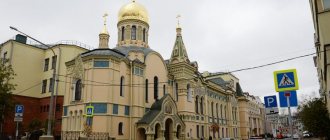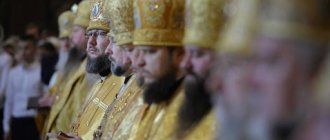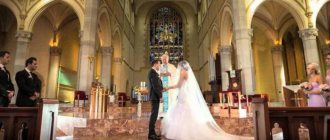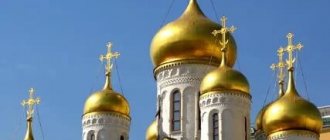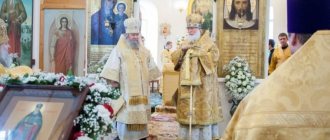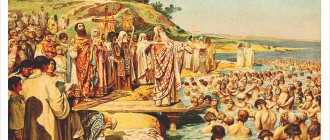From history we know that as a result of the reforms of Patriarch Nikon and Tsar Alexei Mikhailovich, a schism arose in the Russian Church. A fairly large group of Orthodox Christians did not recognize the new liturgical rite and refused to recognize such innovations.
As a result, the so-called “Old Believers” were persecuted by the state and church leadership. At the same time, not everyone has heard that already in the 18th century “Old Believers” began to pray in New Believers parishes. This phenomenon is called “uniform faith” and symbolizes the fullness of the Church.
Church reform of Patriarch Nikon, as a result of which Old Believers (co-religionists) appeared
What is unity of faith?
What does a common faith church mean? This is one of the trends in the Old Believers, which appeared in the 18th century. The main difference between Edinoverie and other Old Believer religious movements is that it recognizes the supremacy of the Moscow Patriarchate.
In other words, co-religionists are not fanatical adherents of professed views, and do not organize communities fenced off from the world in the taiga wilds. They just conduct their services a little differently, and their temples are located in almost every historically significant city. For example, there is a Edinoverie church in Moscow (and more than one); there are parishes in St. Petersburg and the Urals.
The Old Believers are often presented as a kind of gathering of “martyrs” rebelling against innovation. This is partly correct, but co-religionists are not like that. Adherents of this version of Orthodoxy are quite adequate and do not try to resist changes or turn back time. They prefer to be part of the Russian Orthodox Church and obey the patriarch.
During the Soviet years, the Edinoverie Church experienced decline, its churches were alienated and desecrated in the same way as all others. However, since the end of the last century, common faith began to revive.
Under Emperor Nicholas II, the Edinoverians began to be called “Orthodox Old Believers”
On April 17, 1905, Emperor Nicholas II issued a decree “On strengthening the principles of religious tolerance.” For the first time in 250 years, he abolished legal restrictions on Old Believers. In 1906-1907, the IV All-Russian Missionary Congress, held in Kyiv, and the VI Department of the Pre-Conciliar Presence declared the equality of the ancient and new rites.
The center of the Edinoverie movement was the community of St. Petersburg, which was headed by the rector of St. Nicholas Cathedral, priest Simeon Ivanovich Shleev.
Hieromartyr Simon (Shleev), Edinoverie Bishop of Okhta. Photo. Circa 1918. His community in St. Petersburg became the center of the Edinoverie movement in the 1900s
In 1909, the Moscow Edinoverie Congress convened, bringing together more than a hundred deputies from clergy and laity. In 1912, the First All-Russian Edinoverie Congress took place in St. Petersburg. He established what is meant by Edinoverie in Russia, and also resolved issues of the internal life of the Edinoverie Church. On January 31, 1912, a group of congress deputies was received by Nicholas II.
At this meeting, Metropolitan Anthony raised the question of the official name of the co-religionists - “Orthodox Old Believers.” Before the Revolution, throughout the Russian Empire there were 600 parishes of the same faith and several monasteries.
What traditions are followed in the Edinoverie?
Edinoverie does not have any special, significant differences from ordinary Orthodoxy. The essence of the religion is the same, the list and order of services are also no different. The difference between co-religionists and ordinary Orthodox Christians lies in their understanding of the organization of everyday life, way of life and, of course, external manifestations of ritual.
Edinoverie is characterized by the following main characterizing nuances:
- double-fingering when making the sign of the cross;
- preservation of ancient liturgical rites and adherence to them;
- conducting rituals based on old printed books published before the schism;
- maintaining a traditional way of life corresponding to Domostroy.
The Edinoverie Church, as a building in which services are held, has no differences from an ordinary Orthodox church, either outside or inside. It is almost impossible to understand before the start of the service that the temple belongs to the Old Believer movement.
What does it mean to be a fellow believer?
What does a common faith church mean? This is, first of all, a person’s adherence to certain spiritual and moral traditions, and only then - the way of life, the nuances of ritual, and so on.
For a fellow believer, spiritual closeness and close communication with other members of the community are important. For such a person it is natural to:
- reading the Midnight Office and the Night Office, that is, morning and evening prayers;
- keeping fasts;
- accompanying any undertaking by turning to the Lord;
- attending community services and meetings;
- donations to the temple;
- all possible assistance to fellow believers;
- constant spiritual self-education and development.
As for any peculiarities in clothing, there are no church regulations for this. If women who are members of a community led by a Edinoverie church do not use decorative cosmetics, wear full-length skirts and rarely take off their headscarves, then religion has nothing to do with it. The peculiarities of the manner of dressing are a personal matter for each person, although, of course, the concept of modesty and dignity is present in Edinoverie, as in other areas of Christianity.
Today, Edinoverie attracts many because moral purity, adherence to traditions and a literal understanding of God’s commandments are important for this direction of Orthodoxy. Women who follow the old rite can take care of the house and children, literally be “behind their husbands” - and no one will blame them for the lack of work and financial income. Men in these communities do not feel worthless. They are the heads of families and are solely responsible for the well-being of their homes. For many, Edinoverie is like an island of the past in the sea of soullessness of the present.
How does life work in the same faith?
In Edinoverie, the concept of “community” is not an empty phrase or a line from a history textbook. All members of the parish (of course, we are not talking about those who drop by at services or into the church by chance) communicate closely with each other and maintain almost family relationships. Joint meals are accepted, spiritual meetings are held. If any difficulties arise, the problems are solved together. Some parishes follow the tradition of “tithing,” that is, donating a tenth of their income to the temple.
The priest, as a rule, is nominated from the community itself. That is, this person often does not have theological education, did not study at the seminary, and is ordained by the will of his heart, spiritual predisposition and, of course, by the decision of the community members. However, this is not an unshakable tradition or rule. Such a custom arose out of necessity, since there are much fewer clergy in the Old Believers than flocks.
In everyday life, in life, fellow believers are guided by what is written in the following books:
- "Domostroy";
- "Stoglav";
- "Helmsman";
- "Son of the Church."
In spirituality, the Edinoverie Orthodox Church follows what is written in the Gospels and other religious books. Believers also do not neglect the instructions of the apostles and saints.
How did the legalization of Edinovery begin?
The first official regulation on churches of the same faith appeared on June 3, 1799. This was a decree of Paul the First, ordering the management of the affairs of the Old Believer Moscow communities to Archbishop Ambrose of Kazan. This decree was preceded by lengthy attempts to “agree”, both on the part of the Old Believers and initiated by the Patriarchate. But, unfortunately, the relationship between the clergy on both sides was more like political bargaining than Christian reconciliation. Both sides put forward lists of demands and claims, calling them “requests.” And, of course, no one compromised. At the same time, both the Old Believers and their opponents did not forget to submit petitions and petitions to the emperor.
Paul's decree became the “first pancake,” which, according to a popular saying, always turns out lumpy. The Kazan archbishop demanded that his co-religionists commemorate the emperor, members of the Synod and the ruling bishop at the great entrance. The Edinoverie Church in Moscow, at the head of which Ambrose was placed, refused to fulfill this demand. For what reasons the spiritual leaders of fellow believers considered the archbishop’s demands unacceptable is now impossible to understand. However, trying to enter the fold of the “dominant church,” as the Old Believers called the official religion, spiritual leaders constantly set conditions and put forward their own demands, forgetting about Christian humility. Of course, there was no talk of any concessions on their part. It is quite possible that behind this position of the leaders of the same faith was hidden the fear of forced changes in their rituals and manner of serving.
But Paul the First was not a person whose will could be neglected. The refusal of the Old Believers to fulfill the demands of the archbishop entailed the following: the Edinoverie Church retained its structure, but again found itself in the position of a heretical sect. The decree signed by the emperor on August 22, 1799 ordered the cessation of all relationships and contacts with the Old Believers. This instruction returned the clergy of the old rite “from heaven to earth.” The leaders of co-religionists were forced to seek rapprochement with the Patriarchate on the terms dictated to them by the Orthodox clergy.
Edinoverie (other self-names - “newly blessed consent”, “ecclesiastical Old Believers”, “spiritual faith”, “Old Belief parishes of the Russian Orthodox Church”) is a trend in the Old Believers, whose supporters, while preserving the ancient liturgical rites (duplicity, service according to old printed books, etc. ) and the ancient Russian way of life recognize the hierarchical jurisdiction of the Moscow Patriarchate.
The possibility of preserving the pre-reform rite in worship was confirmed by the initiator of church innovations - Patriarch Nikon. After the reunification of the Old Believer Gregory (John) Neronov with the dominant church, he was allowed to perform services using old printed books. Nikon himself, after leaving the patriarchal power, published the Book of Hours in 1658 in the Iveron Monastery, which used the double alleluia preserved by the Old Believers and the pre-reform text of the Creed. During the period of the late XVII-XVIII centuries, isolated cases of Old Believer communities joining the dominant church with their preservation of ancient liturgical rites occurred in many places and were permitted by local bishops: Metropolitan Hilarion of Suzdal, Archbishop of Novgorod Dimitri (Sechenov), Bishop of Pskov Gideon (Krinovsky), Archbishop Astrakhan and Stavropol Nikifor (Feotoki). Activities of the monk Nicodemus
In connection with the extinction of pre-reform priests, the position of the Old Believers accepting the priesthood (priests) became more and more difficult, which is why at the end of the 18th century a strong trend arose to seek compromises with the dominant church. One of the initiators of this movement was the rector of the Assumption Old Believer Monastery on the river. Kamenka in Starodubye (Chernigov province) monk Nikodim. In 1781, on the advice of Count Rumyantsev of Transdunay, through the monk of the Old Believer Nativity Monastery Gerasim (Knyazev), Nikodim sent a letter to St. Petersburg outlining his vision of the problem. Metropolitan of St. Petersburg Gabriel (Petrov), Archbishop of Pskov Innocent (Nechaev) and Prince G. A. Potemkin supported the aspirations of the monk Nicodemus and promised him their support. Having the consent of 1,500 Old Believers, the monk Nikodim in 1783 set out in 12 points in a petition addressed to the Empress and the Holy Synod the conditions under which the Old Believers-priests agreed to reunite with the dominant church. There were several main conditions: a) that the oaths of previous Russian councils on the old rites be canceled; b) that the Old Believers be granted a chorebishop, who is directly dependent on the Holy Synod; c) so that this bishop provides priests for them and all divine services are performed according to the old, pre-Nikon rite; d) so that the Holy Synod supplies them with the holy world; e) that the entire flock of this chorebishop be given the right not to shave their beards and not to wear German dress. The unexpected death of the monk Nikodim on May 12, 1784 slowed down the process somewhat, but did not stop it. The Starodub Old Believers, who agreed with the monk Nikodim, submitted a new petition in 1787, but from 10 points in which there was no mention of a separate chorebishop: they asked only for the priests who were sent in 1788. The new inspirer of the ideas of the “newly blessed consent” after the monk Nicodemus was Archpriest Andrei Ioannov, who himself converted from the Old Believers to the Edinoverie; he became known as the author of the first systematic work after the “Want” of Demetrius of Rostov, “Historical News of the Schismatics,” compiled on the basis of rare primary sources. From Starodubye, the movement for common faith began to spread widely throughout the country: in 1788, a parish appeared in Elizavetgrad; in 1791 - in Troitskaya Sloboda on the river. Dniester; in 1794 - in Perm; in 1797 - in Kazan; in 1798 - in Alexandria, Irkutsk province, in Tver, Torzhok, Tver province, in Nizhny Novgorod, in St. Petersburg and, finally, in 1800 - in Moscow. Since 1787, a Edinoverie monastery also operated 30 versts from Kherson.
Church of St. Simeon the Stylite in the Nizhny Novgorod Kremlin (edinoverticheskaya since 1844, destroyed).
Church of the Introduction (winter) in Lefortovo, formerly belonging to the Vvedenie co-religionists
Trinity Church (summer) in Lefortovo (1819), formerly belonging to the Vedinsky Edinoverieties
“In the Moscow Trinity Edinoverie Church, on June 3, an unprecedented celebration took place: two Old Believer bishops - Onufriy Brailovsky, vicar of the Belokrinitsky Metropolis, and Paphnuty Kolomensky, with three other persons from the schismatic hierarchy, the Belokrinitsky priest-monk Joseph, Archdeacon of Metropolitan Kirill Philaret , and the Belokrinitsky hierodeacon Melchizedek, were solemnly annexed to the Orthodox Church on the rules of unity of faith. Rumors about the intention of some schismatic bishops to turn to the Orthodox Church had long been circulating in Moscow, especially in the Old Believer society, which was greatly alarmed by these rumors. The persons mentioned above, indeed, at the beginning of this year, declared their intention to leave the schism to His Eminence Philaret, Metropolitan of Moscow, asking for his saintly blessing for their undertaking and fatherly assistance in bringing it to fruition. The venerable archpastor of Moscow took a very active part in their situation. After repeated meetings and lengthy conversations with them, appreciating the merits of the motives that disposed them to abandon the schism, and being fully convinced of the complete sincerity of their disposition towards the Orthodox Church, he took special attention to arranging the matter of their annexation...” (1865 “Moscow Vedomosti"). At the request of the Old Believers prior to 1800, the relations and position of the United Old Believer churches within the borders of the Russian Orthodox Church were not regulated in detail and were left to the discretion of the local bishop. In May 1799, the Moscow Old Believers, having failed in negotiations with Metropolitan Platon (Levshin), made a request personally to the emperor, in which they petitioned for the granting of a separate bishop based in Rogozhskaya Sloboda. According to the petitioners, this bishop would have to govern all the Old Believers who joined the Russian Church. On June 3, 1799, the emperor issued a decree by which he ordered Archbishop Ambrose of Kazan (Podobedov) to manage the affairs of the Moscow Old Believers. The latter expressed a number of demands (commemoration at the Great Entrance of the Tsar, the Synod and the ruling bishop) which the Old Believers refused to fulfill. The new imperial decree of August 22, 1799 ordered the cessation of all relations with the Moscow Old Believers. The hard line of Paul I forced the Old Believers of Moscow to again seek rapprochement, but on the terms limited by Metropolitan Platon (Levshin). Later, on the basis of the “petition for the acceptance into Edinoverie of the Old Believers of Nizhny Novgorod and Moscow, Edinoverie, as a form of reunification of the Old Believers with the Orthodox Church,” was regulated in detail by the “points on Edinoverie” of Metropolitan Plato, approved by Emperor Paul on October 27, 1800. November 9, 2000 marked two hundred years since the official establishment of Edinoverie (Old Believer) parishes within the Russian Orthodox Church by the Sovereign Emperor Paul I and the Holy Synod. They arose on the initiative of the Old Believers, who wanted to emerge from the schism while retaining their right to the Old Orthodox liturgical traditions. Edinoverie parishes are an inextricable part of the Orthodox Church and are canonically subordinate to its bishops. They preserve ancient liturgical regulations, two-fingered singing, and medieval unison znamenny singing. With the establishment of Edinoverie, a difficult and not always successful process of overcoming the Russian Church Schism, which had its roots in the mid-17th century, began. Edinoverie serves the task of reconciliation and restoration of Church unity in Rus'. It professes the fundamentally important idea that, given the commonality of dogmatic teaching, ritual differences are not a sufficient basis for dividing believers. The old and new rites are equally honorable and can coexist within the framework of a single Church. Through its entire historical destiny, Unity of Faith embodied the desire to overcome division. While the division of believers along ritual lines has persisted to this day, the overall situation has changed significantly. The former mutual rejection and senseless reproaches have been replaced by mutual respect, a desire for understanding and dialogue between supporters of the old and new rituals. And this is the merit, in particular, of Edinoverie. On August 8, 1832, a decree of the Holy Synod was issued, which facilitated the transition to the so-called common faith. “unregistered Old Believers,” but this did not change the general cool attitude of the hierarchs of the Russian Orthodox Church towards the idea of unity of faith. The majority of bishops adhered to the view of the same faith according to which it was allowed in the sense of “the good hope that the Old Believers of the same faith will eventually be enlightened by God and will come to an agreement in no way different from the Church.” This position was held by: Metropolitan Platon (Levshin), Metropolitan of Moscow (later St. Petersburg) Seraphim (Glagolevsky), Archbishop of Ryazan Filaret (Amphiteatrov), Metropolitan of Moscow Filaret (Drozdov). In 1906-1907, the IV All-Russian Missionary Congress, held in Kyiv, and the VI Department of the Pre-Conciliar Presence declared the equality of the ancient and new rites. The center of the Edinoverie movement was the community of St. Petersburg, which was headed by the rector of St. Nicholas Cathedral, priest Simeon Ivanovich Shleev. In 1910, the First All-Russian Edinoverie Congress met in Moscow, bringing together more than a hundred deputies from clergy and laity. The representative from the Synod at the congress of fellow believers was Archbishop of Vyborg and Finland Sergius (Stragorodsky). From January 22 to January 30, 1912, the Second All-Russian Edinoverie Congress was held in St. Petersburg, chaired by Archbishop Anthony (Khrapovitsky) of Volyn. On the agenda of the congress were: revision of the rules of unity of faith; issues of worship in churches of the same faith; issues related to the organization of the society of Edinoverie and the general management of Edinoverie in Russia; the question of the oaths of the Moscow Councils of the 17th century; the problem of attracting Old Believers-Beglopopovites and representatives of other accords into the fold of the Orthodox Church. On January 31, 1912, a group of congress deputies was received by Nicholas II. At this meeting, Metropolitan Anthony raised the question of the official name of the co-religionists - “Orthodox Old Believers.” By 1918, there were about 600 Edinoverie parishes and several monasteries operating on the territory of the Russian Empire. The Local Council of 1917-1918 approved the right of fellow believers to special Old Believer bishops with suffragan status: - Simon (Shleev) (June 3, 1918 - September 12, 1921), Bishop of Okhtensky, under the jurisdiction of the Metropolitan of Petrograd (since 1920 Bishop of Ufa); — Ambrose (Sosnovtsev) (1918-1926) Bishop of Mstera, vicar of the Vladimir diocese; - Job (Rogozhin), Bishop of Volsky, vicar of the Saratov diocese (May 9, 1920 - summer 1922), Bishop of Mstera, vicar of the Vladimir diocese (1927 - April 20, 1933); - Nikanor (Kudryavtsev) (1921 - October 30, 1923) Bishop of Bogorodsk, vicar of the Moscow diocese; - Pavel (Volkov) (July 17, 1922-1929) Bishop of Kerzhensky, vicar of the Nizhny Novgorod diocese; - Iriney (Shulmin) (January 27 - November 2, 1923) Bishop of Kushvinsky, vicar of the Sverdlovsk diocese; - Peter (Gasilov) (December 21, 1922 - February 11, 1924) Bishop of Satkinsky, vicar of the Ufa diocese; - Rufin (Brekhov) (May 7, 1925 - 1930) (shot in 1937) Bishop of Satkinsky, vicar of the Ufa diocese; - Vassian (Veretennikov) (September 20, 1926 - March 1937) Bishop of Satkinsky, vicar of the Ufa diocese. The Resolution (“Act”) of the Holy Synod of the Russian Orthodox Church, chaired by the Deputy Patriarchal Locum Tenens, Metropolitan Sergius (Stragorodsky), dated April 10 (23), 1929, recognized the equal salvation of the old rite, removed the oaths of the Old Believers and invalidated the resolutions of the Great Moscow Council of 1666-1667. This Resolution was confirmed by the Local Council of the Russian Orthodox Church in 1971, which also pointed out the unnecessary and violent nature of the church reform of the 17th century and finally established the identity of not only Edinoverie, but also the Old Believers with Orthodoxy: “The Consecrated Local Council lovingly embraces all those who sacredly preserve the ancient Russian rites, both members of our Holy Church and those who call themselves Old Believers, but who sacredly profess the saving Orthodox faith.” Moreover, the Council, we repeat once again, allowed the Holy Mysteries to be taught not only to fellow believers, but also to Old Believers, “as they have unity with us in the sacraments.” At the Local Council of 1988, the definitions of the 1971 Council were repeated. In Soviet times, only 3 parishes of the same faith were not closed (the village of Maloe Murashkino, in Latvia and the Kirovograd diocese of Ukraine). The last temple of Moscow co-religionists until the 1960s. There was a St. Nicholas Church at the Rogozhskoe cemetery, after which Edinoverie services were held only in the southern (in the name of the Icon of the Mother of God of the Three-Handed) aisle of this temple (they stopped in 1988). After the collapse of the communist system, Edinoverie in the Russian Orthodox Church began to revive in a slightly different form - the initiative to create parishes comes from below, representing a kind of “internal emigration” to the Russian Orthodox Church from among Nikon’s unacceptable ritual innovations and represents the conservative part of the Russian Orthodox Church (quite often modern coreligionists do not have a direct continuity from the previous ones). In 2000, the Russian Orthodox Church celebrated two major anniversaries: the bicentenary of Christianity and the bicentennial of the establishment of Unity of Faith in the Russian Orthodox Church. In 1999, the United Faith parishes of Russia decided to create an organizational commission to prepare and conduct festive celebrations. A program of anniversary events was developed, which was approved and blessed by His Holiness Patriarch Alexy II of Moscow and All Rus'. The bishops of the Russian Orthodox Church provided great assistance to fellow believers in the process of preparing for the anniversary. Metropolitan Vladimir of St. Petersburg and Ladoga and Metropolitan Kirill of Smolensk and Kaliningrad, Chairman of the Department of External Church Relations, showed particular interest in this work. The official anniversary celebrations were preceded by the concelebration of the rectors of the main Edinoverie parishes in Russia, who served a festive liturgy on the morning of November 26, 2000 in the Church of St. Nicholas in Studenci. At the end of the service, an excursion to Edinoverie places in Moscow and the Moscow region was organized, and organizational issues were also resolved. On the day of remembrance of St. Apostle Philip and St. Gregory Palamas, Archbishop of Thessaloniki, November 27, 2000, celebrations dedicated to the 200th anniversary of the Unity of Faith in Russia began in Moscow. They were attended by representatives of the majority of Old Believer / Edinoverie / parishes of the Moscow Patriarchate, as well as other Old Believer concords: 1. Parish of the Church of St. Nicholas in Studenci, Moscow, rector of the monks Peter. 2. Parish of the Church of the Archangel Michael, village of Mikhailovskaya Sloboda, Moscow region, rector of the monastery Irinarch. 3. Parish of the Church of the Transfiguration of the Lord, city of Kurovskoye, Moscow region, rector Priest Fr. Dmitriy. 4. Parish of the Church of the Vladimir Icon of the Mother of God, village of Ostashevo, Moscow region, rector priest Fr. Sergius. 5. Parish of the Church of St. Nicholas on Marata Street, St. Petersburg, rector priest Fr. Peter. 6. Parish of the church in Nizhny Tagil, Yekaterinburg region, rector priest Fr. Leonty. 7. Parish of the Church of the Intercession of the Virgin, village of Malye Murashki, Nizhny Novgorod region, rector priest Fr. Basil. 8. Priest of the same faith, priest Fr. Anthony, Rostov. 9. Parish of the chapel of the Tikhvin Icon of the Mother of God, village of Pavlovo on the Neva, Leningrad region, chairman of the parish council Chizh S.Z. 10. Representatives of the same faith communities of Pskov, Nizhny Novgorod. 11. Parish of the Church of the Nativity, Erie, Pennsylvania, USA. — RPZTs., about. John. 12. Representative of the Pomeranian Old Believer Grebenshchikov community in the city of Riga (Latvia), senior mentor Ioann Mirolyubov. 13. Representatives of the Ancient Orthodox Pomeranian Church of Belarus. 14. Chairman of the Pomeranian Old Believer community in the city of Minsk - Klementyev V. E. 15. Representatives of the Pomeranian Old Believer communities of Lithuania. 16. Representatives of Pomeranian communities in Moscow and other cities of Russia. With the blessing of His Holiness Patriarch Alexy II of Moscow and All Rus', within the walls of the Assumption Cathedral of the Moscow Kremlin, priests of the same faith performed a prayer service to the Savior according to the ancient rite. The service was led by the holy monk Peter, rector of the Church of St. Nicholas in Studenci. The service was attended by hierarchs of the Russian Orthodox Church: Metropolitan of St. Petersburg and Ladoga Vladimir, Metropolitan of Krutitsky and Kolomna Yuvenaly, Metropolitan of Smolensk and Kaliningrad Kirill. Believers from all over Russia arrived in the Moscow Kremlin, who were unforgettably impressed by the beauty of the ancient banner singing of the combined choir of co-religionists and Old Believers within the walls of the Assumption Cathedral (the leader of the Church of St. Nicholas in Studentsy is A. G. Ustinov). The worshipers felt a sense of great significance of what was happening, realizing that over the past 350 years this was the first ancient Orthodox service in the Assumption Cathedral, to which the original ancient piety had returned. The service ended with a sermon by Metropolitan Kirill of Smolensk and Kaliningrad, in which he warmly congratulated those present on the anniversary. Noting that he is pleased with the unity in the Council of Old Believers of different agreements, which is the key to overcoming church differences. Vladyko emphasized the fallacy of Russian state and church policies, which led to the division of believers in the mid-17th century. They were about. At the end, bidding farewell to the Assumption Council, believers venerated the relics of the holy first hierarchs of the Russian Orthodox Church. Then, an anniversary conference was held at the St. Daniel Monastery. It was opened with a welcoming speech by His Holiness Patriarch Alexy II of Moscow and All Rus': “To the children of the Russian Orthodox Church who preserve ancient Russian rites in worship in connection with the 200th anniversary of the canonical existence of Old Believer parishes in the bosom of the Moscow Patriarchate.” Edinoverie community of St. Petersburg - https://edinoverie.narod.ru/history_vozniknovenie.html Russian Orthodox Church (ROC) Russian Old Believer Church
Copyright © 2022 Unconditional love
How and when was Edinoverie established?
The establishment of Edinoverie churches as an integral part of Russian Orthodoxy took place on October 27, 1800. It was on this day that Emperor Paul the First accepted the “Petition for the admission of the Old Believers of Nizhny Novgorod and Moscow into the common faith.” At the same time, the concept of “uniform faith” was introduced, which was a form of designation of the reunification of the Old Believers with the existing Orthodox Church.
However, this reunion was quite strange. For example, the provisions adopted at the councils of the 17th century regarding the making of the sign of the cross with two fingers and the performance of other old ritual rites were not repealed. These provisions were called "oaths." The meaning of the word in this case is similar to the meaning of the term “curse”. Conciliar oaths were taken only by bishops and on an individual basis. Only those who accepted the “new rite”, that is, reunited with the dominant church, were freed from them. Such people were then called co-religionists.
The founder of the Edinoverie movement was the monk Nicodemus
The emergence of the Edinoverie movement in Russia is associated with the name of the monk Nicodemus. The prerequisites for this were a sharp reduction in the number of priests of the pre-reform regulation among the Old Believers accepting the priesthood (priests).
His goal was reconciliation with representatives of the dominant church. One of the initiators of such a movement was the rector of the Assumption Old Believer Monastery on the Kamenka River in Starodubye (Chernigov province), monk Nikodim.
His Serene Highness Prince G.A. Potemkin shortly before his death. Potemkin was one of those who supported the leader of fellow believers, monk Nicodemus
In 1781, Count Rumyantsev-Zadunaisky advised Nikodim, through the monk of the Old Believer Nativity Monastery Gerasim (Knyazev), to send a letter to St. Petersburg with his proposals. Metropolitan of St. Petersburg Gabriel (Petrov), Archbishop of Pskov Innocent (Nechaev) and Prince G. A. Potemkin supported the aspirations of the monk Nicodemus and promised him their support.
Two years later, Nicodemus, with the consent of 1,500 Old Believers, sent a petition to the Empress and the Holy Synod. In it, in 12 points, he outlined the conditions under which the Old Believers-Priests agreed to reunite with the dominant church. The main conditions were the following:
- the abolition of the oaths of former Russian councils to the old rites;
- the granting of a bishop to the Old Believers, who would be directly dependent on the Holy Synod;
- granting the right to the bishop to appoint priests for the Old Believers-priests and to perform all services according to the old, pre-Nikon rites;
- supplying the Old Believers with peace by the Holy Synod;
- granting the bishop's flock the right to wear beards and Russian dress.
“Holiday” (Old Believer manuscript, Guslitsy, late 19th century).
One of the demands of fellow believers to the authorities was the demand to allow them to perform divine services in the bosom of the Russian Church according to the old liturgical books. On May 12, 1784, the monk Nicodemus unexpectedly died. His associates submitted a new petition in 1787. But it consisted of 10 points and no longer mentioned a separate bishop. The Old Believers now asked only for the priests who were sent to them the following year.
Another inspirer of the Edinoverie movement was Archpriest Andrei Ioannov, who converted from the Old Believers to Edinoverie.
What did the establishment of Edinoverie lead to?
Probably, after such a reunion, most believers felt not relief, but bewilderment. Those who followed the old rite considered themselves devoted spiritual leaders. The establishment of a common faith led to the fact that people began to go into the wilderness, away from the world, and establish isolated communities there.
Of course, a minority of believers did this. The majority had something to lose, and they did not want to leave everything they had acquired because of political games. Most of the Old Believers were merchants; for example, the Edinoverie Church in St. Petersburg had practically no representatives of other classes among its parishioners. The merchants were pious people, but at the same time very pragmatic.
This class accepted all the acts regulating the Old Believers, but how sincerely no one can answer now. Services according to the old rite with the making of the sign of the cross continued even after the introduction of the concept of “uniform faith,” but were not advertised. Old-style icons were painted and placed in churches and houses. The way of life has also been preserved. However, outwardly everything looked as if the dominant church had absorbed the Old Believers.
Some Edinoverie parishes in Moscow
When it comes to Old Believer parishes in the capital, most people remember the Edinoverie Church on Taganka. This is a very beautiful temple with a special atmosphere, which you just want to go into. It’s hard to believe that the church was abandoned for many years and was only reconsecrated in 1996.
The Church of St. Nicholas on Studenets is located on Taganskaya Street in the building number 20a. He is often mistakenly called Nikolsky. St. Nicholas Edinoverie Church is located not in Moscow, but in St. Petersburg. There is no need to call the temple on Taganka Nikolsky, this is not the correct version of the name.
Although the church on Taganka is currently most famous among believers who follow the old rite, another temple is much more interesting. In the very center of Moscow, on Bolotny Island, notorious to all lovers of Russian history, stands the Church of the Life-Giving Trinity, or, as the priests call it, the Church of St. Nicholas.
You can find it at Bersenevskaya embankment, building 18/22. This is literally a few steps from the world-famous monument of the Stalin era - the House on the Embankment, in which representatives of the Soviet elite lived and from where secret service workers took them away in the mornings. And even closer to this temple is an inconspicuous old building of a couple of floors with a modest historical plaque. These are the chambers of Malyuta Skuratov. There are many more legends and scary stories about this house than about the “stone monster” of the Soviet era.
Despite such a specific location, the temple has a unique energy. Although it is still in the process of reconstruction, the doors are already open for believers and the curious. This moment is quite interesting: when leaving this temple, a person sees the Cathedral of Christ the Savior, located on the other side of the embankment.
Speaking about the parishes of the same faith in the capital, one cannot ignore the Church of the Intercession of the Blessed Virgin Mary, located in Rubtsov. It is notable for the fact that it is the center of the ancient Russian liturgical tradition. In other words, the representation of the Patriarch. This church is located on Bakuninskaya Street, in building 83.
About some Edinoverie churches in the Moscow region
When it comes to churches in the Moscow region, most people remember the Trinity-Sergius Lavra. Meanwhile, this is far from the only spiritual center located close to the capital. There are a lot of churches in the Moscow region, including those of the same faith.
They are in completely different states. Some glitter with gold domes and are overcrowded during services. Others are in desperate need of both restoration and congregations.
For example, in a village called Avsyunino, near Orekhovo-Zuevo, there is St. Peter’s Church. The official name of this temple is the Church of Peter, Metropolitan of Moscow. The first service was held here in the bloody year of 1905. The construction of the church building began in 1903. This is surprising - just a few tens of kilometers from terrorists throwing homemade bombs, from endless protests and demonstrations, the participants of which often did not understand in principle what they stood for and what they were called to, then, when the cadets and gendarmes shot at the crowd of believers who came “to the Tsar,” a new temple was built and opened here, in a small village.
Now there is a priest here, but the building itself is in desperate need of not just reconstruction, but practically rebuilding.
Another very symbolic place can be considered the church located in the Voskresensky district, in the village of Ostashovo. The Church of the Vladimir Icon of the Blessed Virgin Mary is a parish in a community of more than two hundred people. This place is noteworthy because the community was not “restored.” It was formed in 1991 from people seeking spirituality and striving to preserve moral and moral principles. Among those for whom it was important to raise their children not in an endless race for material values, but within the framework of the old traditions of Russian spirituality.
The church is open, and services are always extremely crowded. This will be of interest to those who would like to know more about modern Russian Edinoverie and its differences from ordinary Orthodoxy.
During the Soviet period, Edinoverie about
The local council of 1917-1918 approved the right to have their own bishops. Edinoverie bishops were present at the III All-Russian Congress of Edinoverietsy in 1927. Later, during the 1920s, the churches of the Old Believers, including Edinoverie, were closed. Believers performed divine services at home according to the secular rite, and individual parishes gradually switched to the new rite.
Edinoverie Bishop of Saktinsky and Kerzhensky Vasian in 1929. After Vassian’s arrest in 1937, Edinoverie parishes began to be governed on a general basis by the Archpastors of the Russian Orthodox Church.
On April 10 (23), 1923, the Provisional Patriarchal Holy Synod recognized the equal salvation of the old and new rites. In addition, he removed the oaths of the Old Believers and invalidated the decrees of the Great Moscow Council of 1666-1667.
In 1937, due to the arrest of Edinoverie Bishop Vassian (Veretnikov), the management of Edinoverie parishes in the dioceses was transferred to local archpastors on a general basis until further orders.
The Local Council of the Russian Orthodox Church in 1971 confirmed this decision, and also pointed out the unnecessary and violent nature of the church reform of the 17th century. He finally established the identity of the liturgical tradition of both fellow believers and Old Believers with Orthodoxy. The Local Council of 1988 and the definitions of the Council of 1971 were repeated.
The former Edinoverie church of St. Nicholas at the Rogozhskoye cemetery (nowadays only New Belief services are held in the church). The Church of St. Nicholas became the last temple of Moscow co-religionists
As a result, communities of the same faith began to dissolve, moving into new-belief parishes. In the late Soviet period, only three parishes of the same faith functioned: in the village of Maly Murashkino, Gorky region, in Latvia and the village of Zlynka, Kirovograd diocese of the Ukrainian SSR. The last church of Moscow co-religionists until the 1960s was St. Nicholas Church at the Rogozhskoye cemetery.
Edinoverie in St. Petersburg
There is a fairly widespread opinion that St. Petersburg is a major center of the Old Believers. The formation of this belief was greatly facilitated by the St. Nicholas Edinoverie Church on Marata Street. This is truly the largest spiritual center for all believers who follow the old rite, despite the fact that there is no “full-fledged” church in the building now.
Walking along Kuznechny Lane, it is impossible to pass by this temple. St. Nicholas Edinoverie Church in St. Petersburg is an incredibly impressive building in the Empire style. It is quite large, but does not give a feeling of bulkiness or grandeur. The building, in principle, does not look like a church; its facade is more reminiscent of a theater or an observatory. Probably, it was the external features that helped the St. Nicholas Church survive Soviet times with fairly minor losses. During the years of Soviet power, St. Nicholas Edinoverie Church of St. Petersburg was used as a museum of the Arctic and Antarctic. Of course, this is a desecration of the temple, but still this option is better than using it as a warehouse or prison.
St. Nicholas Edinoverie Church was built in 1838. Its construction lasted 18 years, and the author of the architectural project was Abraham Melnikov. In 1919, the church was given the status of a cathedral church. Accordingly, he received the parish and all the rights of county and city cathedrals. It should be noted that the application for the assignment of this status was submitted back in 1910. At the beginning of the last century, in St. Petersburg and its environs, there were several thousand believers who followed the old rite. Of course, they were all co-religionists or were considered such. But, despite the obvious need to give the temple the status of a cathedral, the patriarchate considered the issue for nine years. It is quite possible that if the revolution had not shaken the position of the church, St. Nicholas Church would not have become a cathedral.
The return of the temple premises to the church is being carried out in stages. This process began in 1992, and by 2013 almost all premises came under church jurisdiction. You can find the St. Nicholas Church on Marata Street, at its intersection with Kuznechny Lane.
“I always wanted to return to Russia”
— You mentioned that you yourself were born into a family of emigrants. How did your family end up in Europe?
— My mother is from the descendants of white emigration. Her parents came to France when they were very young. And she was born in Paris, and studied there. Then her father, who was an engineer, began to come to the Soviet Union from time to time - at that time, French engineers happened to help build various objects for the USSR. And his wife, my grandmother, was related to my other grandmother, my father’s mother. Thanks to this, my grandfather met my father’s parents, and later my parents met each other.
Mom worked as a translator at that time and in the late 1970s came to work in Moscow - at the Cosmos Hotel, which was also built by the French. My parents got married here, and I was brought here soon after I was born. We returned to France before the 1980 Olympics.
Since then we lived in France, but every summer for two or three months I came to my grandparents, my father’s parents: they had a dacha in the Moscow region. My father remained in France until the end of the 1980s: we were afraid that if he came to Moscow, he might not be released again. My mother, brothers and I were French citizens and came here relatively freely. In any case, they gave us visas.
Bishop Savva's great-great-grandfather - priest Nicholas with his mother Photo tutunov.org
— Was the family churchgoing?
- Yes, church. I was baptized here in Moscow, in the Church of the Prophet Elijah the Ordinary, where my parents got married, and where my grandmother was a member of the “twenty.” When we moved to France, we continued to go to church there too.
- Which was subordinate to the Patriarchate of Constantinople...
- Yes. This was the Church of Saints Equal-to-the-Apostles Constantine and Helen - as far as I know, the very first of the churches built in France by the first wave of Russian emigration. Orthodox churches were built in France even before the 1917 revolution - Alexander Nevsky Cathedral in Paris, St. Nicholas Cathedral in Nice and others; but of those that were built after the revolution, this is the first. It is located in Clamart, a suburb of Paris, and at that time was part of the Patriarchate of Constantinople.
— What do you remember from the church life of those times?
— It is likely that all the parishes—at least, the vast majority of them—were very small in number. All the parishioners knew each other, and the priest knew each of them by name. This left its mark on relationships in the community and on the life of the parish.
And the whole “Russian Paris” - ten parishes - most of the parishioners also knew each other and communicated warmly, there were a lot of family connections. Sometimes it was reminiscent of relationships in a communal apartment - both in a good and not a very good sense of the word: some gossip could spread, people could quarrel with each other, etc. But one way or another, the relationship was very personal, and it was the strong point of Russian parishes in foreign countries.
Patriarch Kirill and Archbishop John (Renetto) during Patriarch Kirill’s visit to France Russian cemetery in Sainte-Genevieve-des-Bois, 2016 Photo by the Press Service of the Patriarch of Moscow and All Rus'
— Obviously, these were no longer the emigrants themselves, but the descendants of those who left Russia in the 1920s?
— Most of the people who left Russia in the first wave of emigration had, of course, already died by the time I was a teenager. With rare exceptions, one of which was my great-grandmother - my mother's grandmother. My grandfather was also alive in the early 1990s, but he emigrated as a small boy.
But many of those who were usually classified as “displaced persons” were alive: during the Second World War, the Germans took them from the occupied territories of the USSR to camps located in Western Europe, where many of them remained after the war. If we talk about representatives of the White Guard emigration, of course, I found mainly representatives of its second or third generation.
— How did these people feel about the Russian Orthodox Church? Didn’t you think it was better to stay away from the “Soviet Church”?
— I don’t remember this among the parishioners of the Patriarchate of Constantinople. We all understood that the Russian Church lives in conditions of persecution, and at the liturgy a special prayer was always read “for our suffering Russian country.” I remember literally a couple of people who periodically walked around talking about the “Soviet Church,” but they were rather the exception and were perceived by me as people with oddities.
September 15, 2022 at the Alexander Nevsky Cathedral in Paris
for the first time after the annexation of the Archdiocese of the Exarchate of Orthodox Russian Churches in Western Europe
to the Russian Orthodox Church sing many years to Patriarch Kirill
— How did it happen that you yourself moved from the jurisdiction of the Patriarchate of Constantinople to the jurisdiction of the Moscow Patriarchate?
— I always wanted to return to Russia. In the last years of my studies at the Lycée Orsay-Paris XI, I was a subdeacon with Bishop Sergius (Konovalov) and intended to remain close to him and help as long as necessary. Moreover, Bishop Sergius, as I already said, worked very hard to return the Archdiocese to the Russian Orthodox Church. In 1999, he sent me to study at the Moscow Theological Seminary, but during the holidays I returned to Paris and helped the bishop. On one of my visits, he tonsured me as a monk. And in 2003, Bishop Sergius died suddenly from a severe form of cancer. There were literally a few days left until he was going to submit a proposal to join the Russian Orthodox Church for discussion at the diocesan meeting...
However, after the death of Bishop Sergius, people came to the diocesan council and other governing bodies of the Archdiocese who rejected the idea of joining the Russian Orthodox Church. Subsequently, these sentiments only intensified: the Russian Church was increasingly being reproached for being authoritarian, for being too connected with the state... I did not share these opinions. In my opinion, the legitimacy of the existence of the Archdiocese - from a historical and canonical point of view - consisted in the fact that over time it would fulfill the intention of Bishop Eulogius and return to the Russian Church. Since the new leadership of the Archdiocese then quite clearly demonstrated its rejection of this path, I decided to move along it on my own.
Edinoverie churches in modern Russia
Of course, there are parishes of the same faith not only in St. Petersburg and Moscow; churches are being restored and opened throughout Russia. And along with their discovery, the Church of the same faith grows stronger. Shuya is one of the major spiritual centers of modern co-religionists. Here, in a small town in the Ivanovo region, there is the All Saints Edinoverie convent. The first mention of this monastery dates back to 1889. Finding the monastery is not difficult; it is located at the crossroads of two streets - Sovetskaya and 1st Metallistov. The territory is open to visitors, there is a temple at the monastery, and there are also church shops.
The Assumption Edinoverie Church is being restored in Donbass. This temple, which was located in Novocherkassk, was completely destroyed. Now a modest chapel has been opened in its place, and it is quite possible that with the resolution of the very difficult situation in the region, the temple will still be completely restored.
Before the revolution, the Edinoverie Church was very strong in the Urals. Yekaterinburg now cannot boast of a large number of open churches. However, on Shkolnikov Street there is a functioning temple - the Church of the Nativity. The building suffered greatly during the Soviet regime, and although it was returned to the church in 1993, restoration work is still underway.
However, in the Urals, not everything is as bad for Edinoverie as it might seem. In the Volga region the situation is more complicated. The Edinoverie Church in Samara still cannot return the unique building of the Church of the Kazan Icon of the Mother of God to its jurisdiction. Although it would be more correct to talk not about the unique building, but about what remains of it. Before the revolution, this church had five “star” domes, in no way inferior to the domes of the churches of Sergiev Posad. The church was built at the expense of the Old Believer community at the end of the century before last. You can see what’s left of it on Nekrasovskaya Street. The building number is 27. In this case, the exact address is important, since it is impossible to understand that the temple building is in front of your eyes.
An interesting place for those interested in Old Believers is the village of Penki. The common faith wooden Church of the Mother of God of Kazan was built here in the middle of the century before last. The temple was consecrated in 1849. It was closed by the authorities and looted in the sad 30th year of the last century. The uniqueness of this church is that it was made of wood in full accordance with all early Russian architectural traditions.
Of course, this is not a complete list of temples and churches related to the same faith. In almost every Russian city there is a community of believers who follow the traditions of the old rite. But, of course, these communities have much fewer church buildings than the average Orthodox Church. After all, although nowadays there is no official conflict between the new and old rituals, co-religionists still do not have equal rights. Those following the old rite are a junior, subordinate to the main dominant church, a spiritual organization.
Edinoverie originated in the 17th century during the reign of Empress Catherine II
After the anathemas of the Moscow Council of 1656 and the Great Moscow Council, a split occurred in the Russian Church. As a result, all those who were baptized with two fingers were declared heretics, excommunicated from the Trinity. Initially they were brutally fought, but later the authorities’ position softened and they began to be called simply schismatics.
Power moved from the policy of exterminating Old Believers to the policy of legalizing them in public life at the beginning of the 18th century, using the method of falsification. Many Old Believer writers pointed out the gross nature of such falsifications.
Portrait of Patriarch Nikon with the clergy, D. Wuchters, 1660-1665. The reforms of Patriarch Nikon led to a schism in the Russian Church and, subsequently, the emergence of unity of faith
Under Peter I, the number of Old Believers in Russia gradually increased. In the 18th century, the idea of common faith arose, that is, the possibility of serving according to the old rite in individual parishes. Despite this, all anathema oaths against double-fingering and the old rites of the councils of the 17th century remained in force.
It is worth noting that supporters of the old rite within the Synodal Church believed that these anathemas were imposed against the rebellious bishop, and not against the rites themselves.
The first mentions of communities belonging to the old rite and located in the bosom of the Russian Orthodox Church by the middle of the 18th century. It was then that Bishop Hilarion of Astrakhan allowed Old Believers to perform divine services in his diocese according to pre-reform books. This happened due to their large number.
Portrait of I. I. Melissino in the gallery of the rectors of Moscow University on Mokhovaya. Ivan Melissino developed the first project for the reconciliation of Old Believers with the Russian Church
At the beginning of the reign of Empress Catherine II, Chief Prosecutor Ivan Melissino developed a special project aimed at reconciling the Old Believers with the Church. The document allowed Orthodox clergy to perform services using old books under the supervision of the Holy Synod.
In addition, at the joint conference of the Synod and the Senate on September 15, 1763, it was stated that “the custom of baptizing with two fingers is not proof of belonging to a schism and should not be prohibited.”


